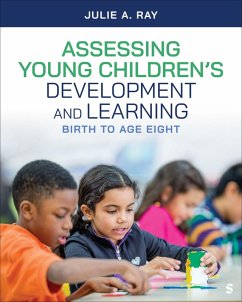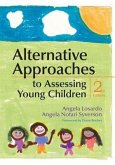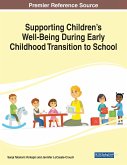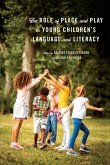- Broschiertes Buch
- Merkliste
- Auf die Merkliste
- Bewerten Bewerten
- Teilen
- Produkt teilen
- Produkterinnerung
- Produkterinnerung
Assessing Young Children's Development and Learning: Birth to Age Eight by Julie A. Ray helps early childhood educators understand both the need for assessment as well as the process of assessment for infants, toddlers, and children up to age eight. This comprehensive text covers a wide range of assessment strategies, from observation to formalized assessments, and further, shows students how to adapt these assessments for a wide variety of students and incorporate feedback from families. Built around the latest National Association for the Education of Young Children (NAEYC) standards from…mehr
Andere Kunden interessierten sich auch für
![Facilitating Children's Learning in the Eyfs Facilitating Children's Learning in the Eyfs]() Ann LangstonFacilitating Children's Learning in the Eyfs32,99 €
Ann LangstonFacilitating Children's Learning in the Eyfs32,99 €![Children Are LIke That!: Observations from the Children's Farm Children Are LIke That!: Observations from the Children's Farm]() Nancy JonesChildren Are LIke That!: Observations from the Children's Farm15,99 €
Nancy JonesChildren Are LIke That!: Observations from the Children's Farm15,99 €![Alternative Approaches to Assessing Young Children Alternative Approaches to Assessing Young Children]() Angela LosardoAlternative Approaches to Assessing Young Children37,99 €
Angela LosardoAlternative Approaches to Assessing Young Children37,99 €![Honoring the Moment in Young Children's Lives Honoring the Moment in Young Children's Lives]() Ron GradyHonoring the Moment in Young Children's Lives24,99 €
Ron GradyHonoring the Moment in Young Children's Lives24,99 €![Children's Talk in Communities and Classrooms Children's Talk in Communities and Classrooms]() Lynne Vernon-FeagansChildren's Talk in Communities and Classrooms27,99 €
Lynne Vernon-FeagansChildren's Talk in Communities and Classrooms27,99 €![Supporting Children's Well-Being During Early Childhood Transition to School Supporting Children's Well-Being During Early Childhood Transition to School]() Supporting Children's Well-Being During Early Childhood Transition to School150,99 €
Supporting Children's Well-Being During Early Childhood Transition to School150,99 €![The Role of Place and Play in Young Children's Language and Literacy The Role of Place and Play in Young Children's Language and Literacy]() Shelley Stagg PetersonThe Role of Place and Play in Young Children's Language and Literacy37,99 €
Shelley Stagg PetersonThe Role of Place and Play in Young Children's Language and Literacy37,99 €-
-
-
Assessing Young Children's Development and Learning: Birth to Age Eight by Julie A. Ray helps early childhood educators understand both the need for assessment as well as the process of assessment for infants, toddlers, and children up to age eight. This comprehensive text covers a wide range of assessment strategies, from observation to formalized assessments, and further, shows students how to adapt these assessments for a wide variety of students and incorporate feedback from families. Built around the latest National Association for the Education of Young Children (NAEYC) standards from 2020, this text offers clear guidance to future educators for licensing requirements and to instructors for program accreditation. Each chapter opens with a vignette to demonstrate the importance of assessment for real classrooms. The chapters conclude with three case studies that apply the chapter¿s contents to each group of students: one for infants and toddlers, one for preschoolers, and one for primary-grade students. These case studies showcase each group¿s unique challenges and settings, providing additional instruction and assessment activities. The Appendix includes a final project and scoring rubric that could be used in course grading or to provide data for accreditation standards. Exercises and activities throughout help readers apply their knowledge, enabling them to confidently and competently assess students in a wide variety of early childhood educational settings.
Produktdetails
- Produktdetails
- Verlag: Sage Publications Inc Ebooks
- Erscheinungstermin: 14. April 2026
- Englisch
- Abmessung: 254mm x 203mm
- ISBN-13: 9781071914281
- ISBN-10: 1071914286
- Artikelnr.: 75126272
- Herstellerkennzeichnung
- Libri GmbH
- Europaallee 1
- 36244 Bad Hersfeld
- gpsr@libri.de
- Verlag: Sage Publications Inc Ebooks
- Erscheinungstermin: 14. April 2026
- Englisch
- Abmessung: 254mm x 203mm
- ISBN-13: 9781071914281
- ISBN-10: 1071914286
- Artikelnr.: 75126272
- Herstellerkennzeichnung
- Libri GmbH
- Europaallee 1
- 36244 Bad Hersfeld
- gpsr@libri.de
Julie A. Ray (Ph.D., University of Missouri, Columbia) is a professor emeritus of Early Childhood Education at Southeast Missouri State University. With 42 years' experience in teaching both young children and undergraduate / graduate early childhood assessment courses, she has seen major changes in the best practices of assessing children's development and learning. As a supervisor of clinical field experiences in the preschool and primary grades, she also observed many real life examples of the complexities in early childhood assessment. Ray is a longtime member of the National Association for the Education of Young Children (NAEYC) and served as a higher education peer reviewer and auditor for programs seeking NAEYC accreditation. This is her second early childhood textbook, as she is the co-author of Home, School, and Community Collaboration with Kathy Grant, now in its 5th edition. These experiences and education have shaped and informed this textbook to be a comprehensive, yet practical guide to the subject of assessment of young children.
Preface
Acknowledgments
About the Author
Chapter 1: Introduction to Developmentally Appropriate Assessment Practices
What is Assessment in Early Childhood Education?
Purposes of Assessment in Early Childhood Education
Essentials of Developmentally Appropriate Assessment
Legal Rights in Assessment of Young Children
Federal and State Assessment Requirements in Early Childhood
Ethical Practices in the Assessment of Young Children
Summary
Key Terms
Chapter Learning Objectives Assessments
Chapter 2: Observation and Documentation: The Foundation of Assessment of
Young Children
Observation + Documentation = Assessment
Developing Close Observation Skills
Errors in Observation
Documenting Individual Children vs. Groups
Evaluating Learning Environments
Observation, Documentation, and the Instructional Cycle
Summary
Key Terms
Chapter Learning Objectives Assessments
Chapter 3: Observation-Based Descriptive Assessment Methods
Observation-Based Assessment Methods that Describe
The Significance of Descriptive Assessment Methods for Planning Instruction
and the Learning Environment
Summary
Key Terms
Chapter Learning Objectives Assessments
Chapter 4: Observation-Based Assessment Methods That Count or Rate
Observation-Based Assessment Methods That Count
Observation-Based Rating Assessment Methods
The Significance of Assessment Methods that Count or Rate for Planning
Instruction and the Learning Environment
Summary
Key Terms
Chapter Learning Objectives Assessments
Chapter 5: Performance-Based Assessment Methods
Performance-Based Assessment
Assessing Performance-Based Tasks: Rubrics
Summary
Key Terms
Chapter Learning Objectives Assessments
Chapter 6: Informal Paper / Pencil Assessments for the Primary Grades
Feedback and Informal Paper / Pencil Assessment Methods
Worksheets as Assessment Tools
Quizzes and Tests
Strengths and Limitations of Informal Paper / Pencil Assessment Methods
Student Self-Assessment
Summary
Key Terms
Chapter Learning Objectives Assessments
Chapter 7: Formal Standardized Assessments
Brief History of Standardized Tests in the U.S.
Types of Standardized Assessments
Validity and Reliability of Standardized Assessments
Interpreting and Explaining Standardized Assessment Results
Communicating Standardized Assessment Results
Strengths and Limitations of Standardized Assessments
Summary
Key Terms
Chapter Learning Objectives Assessments
Chapter 8: Using Portfolio Data to Plan Instruction
Types of Portfolios
Implicit Bias in Artifact Collection
Involving Children in the Portfolio Process
Using Portfolio Documents to Plan Instruction and Set Goals
Electronic Portfolio Systems
Benefits and Challenges of Portfolios
Summary
Key Terms
Chapter Learning Objectives Assessments
Chapter 9: Using Assessment Data to Support Development, Learning, and
Program Improvement
Choosing the Correct Assessment Method
Documentation in Early Childhood Education Models
Data-Based Decision Making
Using Data to Improve Programs and the Environmental Setting
Summary
Key Terms
Chapter Learning Objectives Assessments
Chapter 10: Using Assessments in Tiered Systems of Support
The Response to Intervention (RTI) Approach
The RTI Approach to Challenging Behaviors in Early Childhood
Professional Learning Communities (PLCs) and Response to Intervention (RTI)
Leadership Teams
RTI and Multi-Tiered Systems of Support (MTSS)
Summary
Key Terms
Chapter Learning Objectives Assessments
Chapter 11: Assessing Children with Developmental Delays or Disabilities
Accommodations and Modifications in Assessments
Referral Process
IFSP / IEP Process: General Education Teacher's Role
Equity in Accessing Special Services
The Educational Team as Assessment Partners
Monitoring the Progress Towards the IFSP Outcomes or IEP Goals
Summary
Key Terms
Chapter Learning Objectives Assessments
Chapter 12: Assessing Linguistically Diverse Children
Linguistic Diversity and Assessment
Stages of Second Language Acquisition
Best Practices in Assessing Children who are Multilingual Learners (MLLs)
Identifying Children who are Multilingual Learners for Special Services
Collaborating with Professional Colleagues and Assessment Partners
Summary
Key Terms
Chapter Learning Objectives Assessments
Chapter 13: Families as Assessment Partners
Family Partnerships in Assessment
Communication Methods for Assessment Information
Informal Communication Methods
Formal Communication Methods
Cross-Cultural Communication Considerations
Families as a Source of Assessment Information
Summary
Key Terms
Chapter Learning Objectives Assessments
Appendix A: Developmental Milestones
Appendix B
References
Acknowledgments
About the Author
Chapter 1: Introduction to Developmentally Appropriate Assessment Practices
What is Assessment in Early Childhood Education?
Purposes of Assessment in Early Childhood Education
Essentials of Developmentally Appropriate Assessment
Legal Rights in Assessment of Young Children
Federal and State Assessment Requirements in Early Childhood
Ethical Practices in the Assessment of Young Children
Summary
Key Terms
Chapter Learning Objectives Assessments
Chapter 2: Observation and Documentation: The Foundation of Assessment of
Young Children
Observation + Documentation = Assessment
Developing Close Observation Skills
Errors in Observation
Documenting Individual Children vs. Groups
Evaluating Learning Environments
Observation, Documentation, and the Instructional Cycle
Summary
Key Terms
Chapter Learning Objectives Assessments
Chapter 3: Observation-Based Descriptive Assessment Methods
Observation-Based Assessment Methods that Describe
The Significance of Descriptive Assessment Methods for Planning Instruction
and the Learning Environment
Summary
Key Terms
Chapter Learning Objectives Assessments
Chapter 4: Observation-Based Assessment Methods That Count or Rate
Observation-Based Assessment Methods That Count
Observation-Based Rating Assessment Methods
The Significance of Assessment Methods that Count or Rate for Planning
Instruction and the Learning Environment
Summary
Key Terms
Chapter Learning Objectives Assessments
Chapter 5: Performance-Based Assessment Methods
Performance-Based Assessment
Assessing Performance-Based Tasks: Rubrics
Summary
Key Terms
Chapter Learning Objectives Assessments
Chapter 6: Informal Paper / Pencil Assessments for the Primary Grades
Feedback and Informal Paper / Pencil Assessment Methods
Worksheets as Assessment Tools
Quizzes and Tests
Strengths and Limitations of Informal Paper / Pencil Assessment Methods
Student Self-Assessment
Summary
Key Terms
Chapter Learning Objectives Assessments
Chapter 7: Formal Standardized Assessments
Brief History of Standardized Tests in the U.S.
Types of Standardized Assessments
Validity and Reliability of Standardized Assessments
Interpreting and Explaining Standardized Assessment Results
Communicating Standardized Assessment Results
Strengths and Limitations of Standardized Assessments
Summary
Key Terms
Chapter Learning Objectives Assessments
Chapter 8: Using Portfolio Data to Plan Instruction
Types of Portfolios
Implicit Bias in Artifact Collection
Involving Children in the Portfolio Process
Using Portfolio Documents to Plan Instruction and Set Goals
Electronic Portfolio Systems
Benefits and Challenges of Portfolios
Summary
Key Terms
Chapter Learning Objectives Assessments
Chapter 9: Using Assessment Data to Support Development, Learning, and
Program Improvement
Choosing the Correct Assessment Method
Documentation in Early Childhood Education Models
Data-Based Decision Making
Using Data to Improve Programs and the Environmental Setting
Summary
Key Terms
Chapter Learning Objectives Assessments
Chapter 10: Using Assessments in Tiered Systems of Support
The Response to Intervention (RTI) Approach
The RTI Approach to Challenging Behaviors in Early Childhood
Professional Learning Communities (PLCs) and Response to Intervention (RTI)
Leadership Teams
RTI and Multi-Tiered Systems of Support (MTSS)
Summary
Key Terms
Chapter Learning Objectives Assessments
Chapter 11: Assessing Children with Developmental Delays or Disabilities
Accommodations and Modifications in Assessments
Referral Process
IFSP / IEP Process: General Education Teacher's Role
Equity in Accessing Special Services
The Educational Team as Assessment Partners
Monitoring the Progress Towards the IFSP Outcomes or IEP Goals
Summary
Key Terms
Chapter Learning Objectives Assessments
Chapter 12: Assessing Linguistically Diverse Children
Linguistic Diversity and Assessment
Stages of Second Language Acquisition
Best Practices in Assessing Children who are Multilingual Learners (MLLs)
Identifying Children who are Multilingual Learners for Special Services
Collaborating with Professional Colleagues and Assessment Partners
Summary
Key Terms
Chapter Learning Objectives Assessments
Chapter 13: Families as Assessment Partners
Family Partnerships in Assessment
Communication Methods for Assessment Information
Informal Communication Methods
Formal Communication Methods
Cross-Cultural Communication Considerations
Families as a Source of Assessment Information
Summary
Key Terms
Chapter Learning Objectives Assessments
Appendix A: Developmental Milestones
Appendix B
References
Preface
Acknowledgments
About the Author
Chapter 1: Introduction to Developmentally Appropriate Assessment Practices
What is Assessment in Early Childhood Education?
Purposes of Assessment in Early Childhood Education
Essentials of Developmentally Appropriate Assessment
Legal Rights in Assessment of Young Children
Federal and State Assessment Requirements in Early Childhood
Ethical Practices in the Assessment of Young Children
Summary
Key Terms
Chapter Learning Objectives Assessments
Chapter 2: Observation and Documentation: The Foundation of Assessment of
Young Children
Observation + Documentation = Assessment
Developing Close Observation Skills
Errors in Observation
Documenting Individual Children vs. Groups
Evaluating Learning Environments
Observation, Documentation, and the Instructional Cycle
Summary
Key Terms
Chapter Learning Objectives Assessments
Chapter 3: Observation-Based Descriptive Assessment Methods
Observation-Based Assessment Methods that Describe
The Significance of Descriptive Assessment Methods for Planning Instruction
and the Learning Environment
Summary
Key Terms
Chapter Learning Objectives Assessments
Chapter 4: Observation-Based Assessment Methods That Count or Rate
Observation-Based Assessment Methods That Count
Observation-Based Rating Assessment Methods
The Significance of Assessment Methods that Count or Rate for Planning
Instruction and the Learning Environment
Summary
Key Terms
Chapter Learning Objectives Assessments
Chapter 5: Performance-Based Assessment Methods
Performance-Based Assessment
Assessing Performance-Based Tasks: Rubrics
Summary
Key Terms
Chapter Learning Objectives Assessments
Chapter 6: Informal Paper / Pencil Assessments for the Primary Grades
Feedback and Informal Paper / Pencil Assessment Methods
Worksheets as Assessment Tools
Quizzes and Tests
Strengths and Limitations of Informal Paper / Pencil Assessment Methods
Student Self-Assessment
Summary
Key Terms
Chapter Learning Objectives Assessments
Chapter 7: Formal Standardized Assessments
Brief History of Standardized Tests in the U.S.
Types of Standardized Assessments
Validity and Reliability of Standardized Assessments
Interpreting and Explaining Standardized Assessment Results
Communicating Standardized Assessment Results
Strengths and Limitations of Standardized Assessments
Summary
Key Terms
Chapter Learning Objectives Assessments
Chapter 8: Using Portfolio Data to Plan Instruction
Types of Portfolios
Implicit Bias in Artifact Collection
Involving Children in the Portfolio Process
Using Portfolio Documents to Plan Instruction and Set Goals
Electronic Portfolio Systems
Benefits and Challenges of Portfolios
Summary
Key Terms
Chapter Learning Objectives Assessments
Chapter 9: Using Assessment Data to Support Development, Learning, and
Program Improvement
Choosing the Correct Assessment Method
Documentation in Early Childhood Education Models
Data-Based Decision Making
Using Data to Improve Programs and the Environmental Setting
Summary
Key Terms
Chapter Learning Objectives Assessments
Chapter 10: Using Assessments in Tiered Systems of Support
The Response to Intervention (RTI) Approach
The RTI Approach to Challenging Behaviors in Early Childhood
Professional Learning Communities (PLCs) and Response to Intervention (RTI)
Leadership Teams
RTI and Multi-Tiered Systems of Support (MTSS)
Summary
Key Terms
Chapter Learning Objectives Assessments
Chapter 11: Assessing Children with Developmental Delays or Disabilities
Accommodations and Modifications in Assessments
Referral Process
IFSP / IEP Process: General Education Teacher's Role
Equity in Accessing Special Services
The Educational Team as Assessment Partners
Monitoring the Progress Towards the IFSP Outcomes or IEP Goals
Summary
Key Terms
Chapter Learning Objectives Assessments
Chapter 12: Assessing Linguistically Diverse Children
Linguistic Diversity and Assessment
Stages of Second Language Acquisition
Best Practices in Assessing Children who are Multilingual Learners (MLLs)
Identifying Children who are Multilingual Learners for Special Services
Collaborating with Professional Colleagues and Assessment Partners
Summary
Key Terms
Chapter Learning Objectives Assessments
Chapter 13: Families as Assessment Partners
Family Partnerships in Assessment
Communication Methods for Assessment Information
Informal Communication Methods
Formal Communication Methods
Cross-Cultural Communication Considerations
Families as a Source of Assessment Information
Summary
Key Terms
Chapter Learning Objectives Assessments
Appendix A: Developmental Milestones
Appendix B
References
Acknowledgments
About the Author
Chapter 1: Introduction to Developmentally Appropriate Assessment Practices
What is Assessment in Early Childhood Education?
Purposes of Assessment in Early Childhood Education
Essentials of Developmentally Appropriate Assessment
Legal Rights in Assessment of Young Children
Federal and State Assessment Requirements in Early Childhood
Ethical Practices in the Assessment of Young Children
Summary
Key Terms
Chapter Learning Objectives Assessments
Chapter 2: Observation and Documentation: The Foundation of Assessment of
Young Children
Observation + Documentation = Assessment
Developing Close Observation Skills
Errors in Observation
Documenting Individual Children vs. Groups
Evaluating Learning Environments
Observation, Documentation, and the Instructional Cycle
Summary
Key Terms
Chapter Learning Objectives Assessments
Chapter 3: Observation-Based Descriptive Assessment Methods
Observation-Based Assessment Methods that Describe
The Significance of Descriptive Assessment Methods for Planning Instruction
and the Learning Environment
Summary
Key Terms
Chapter Learning Objectives Assessments
Chapter 4: Observation-Based Assessment Methods That Count or Rate
Observation-Based Assessment Methods That Count
Observation-Based Rating Assessment Methods
The Significance of Assessment Methods that Count or Rate for Planning
Instruction and the Learning Environment
Summary
Key Terms
Chapter Learning Objectives Assessments
Chapter 5: Performance-Based Assessment Methods
Performance-Based Assessment
Assessing Performance-Based Tasks: Rubrics
Summary
Key Terms
Chapter Learning Objectives Assessments
Chapter 6: Informal Paper / Pencil Assessments for the Primary Grades
Feedback and Informal Paper / Pencil Assessment Methods
Worksheets as Assessment Tools
Quizzes and Tests
Strengths and Limitations of Informal Paper / Pencil Assessment Methods
Student Self-Assessment
Summary
Key Terms
Chapter Learning Objectives Assessments
Chapter 7: Formal Standardized Assessments
Brief History of Standardized Tests in the U.S.
Types of Standardized Assessments
Validity and Reliability of Standardized Assessments
Interpreting and Explaining Standardized Assessment Results
Communicating Standardized Assessment Results
Strengths and Limitations of Standardized Assessments
Summary
Key Terms
Chapter Learning Objectives Assessments
Chapter 8: Using Portfolio Data to Plan Instruction
Types of Portfolios
Implicit Bias in Artifact Collection
Involving Children in the Portfolio Process
Using Portfolio Documents to Plan Instruction and Set Goals
Electronic Portfolio Systems
Benefits and Challenges of Portfolios
Summary
Key Terms
Chapter Learning Objectives Assessments
Chapter 9: Using Assessment Data to Support Development, Learning, and
Program Improvement
Choosing the Correct Assessment Method
Documentation in Early Childhood Education Models
Data-Based Decision Making
Using Data to Improve Programs and the Environmental Setting
Summary
Key Terms
Chapter Learning Objectives Assessments
Chapter 10: Using Assessments in Tiered Systems of Support
The Response to Intervention (RTI) Approach
The RTI Approach to Challenging Behaviors in Early Childhood
Professional Learning Communities (PLCs) and Response to Intervention (RTI)
Leadership Teams
RTI and Multi-Tiered Systems of Support (MTSS)
Summary
Key Terms
Chapter Learning Objectives Assessments
Chapter 11: Assessing Children with Developmental Delays or Disabilities
Accommodations and Modifications in Assessments
Referral Process
IFSP / IEP Process: General Education Teacher's Role
Equity in Accessing Special Services
The Educational Team as Assessment Partners
Monitoring the Progress Towards the IFSP Outcomes or IEP Goals
Summary
Key Terms
Chapter Learning Objectives Assessments
Chapter 12: Assessing Linguistically Diverse Children
Linguistic Diversity and Assessment
Stages of Second Language Acquisition
Best Practices in Assessing Children who are Multilingual Learners (MLLs)
Identifying Children who are Multilingual Learners for Special Services
Collaborating with Professional Colleagues and Assessment Partners
Summary
Key Terms
Chapter Learning Objectives Assessments
Chapter 13: Families as Assessment Partners
Family Partnerships in Assessment
Communication Methods for Assessment Information
Informal Communication Methods
Formal Communication Methods
Cross-Cultural Communication Considerations
Families as a Source of Assessment Information
Summary
Key Terms
Chapter Learning Objectives Assessments
Appendix A: Developmental Milestones
Appendix B
References








